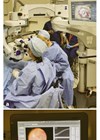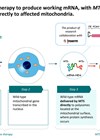A research team has been awarded significant funding by the National Institute for Health and Care Research (NIHR) to develop an innovative drug-device combination that aims to revolutionise how individual immune cells are monitored and treated in patients at Moorfields Eye Hospital. Eye News were lucky to sit down with lead investigator, Dr Colin Chu, to find out more…

Can you tell us how this project first came about? What inspired the idea of using the eye as a window into wider systemic conditions?
We’ve known for a long time that the eye can be used to diagnose and even monitor systemic disorders, such as diabetes, cardiovascular or genetic diseases. It’s been almost impossible however to detect immune cells in the retina, which has limited our understanding of autoimmune diseases such as posterior uveitis.
This project is built on years of work from many wonderful collaborators, where we identified the potential of a dye called indocyanine green (ICG) to label immune cells. We are now ready to refine and test this approach in patients.
Why focus on posterior uveitis specifically, and what makes it such a difficult form of ocular inflammation?
While posterior uveitis is the least common form of uveitis, it is the most likely to lead to severe visual loss and can be challenging to manage for ophthalmologists. Patients frequently need systemic immunosuppression, exposing them to significant risks, but we lack a robust method for knowing if and how the treatment is working.
What’s innovative about the imaging technology itself – how does it differ from what clinicians are currently using?
In current clinical practice, most retinal diseases are managed using indirect measures, such as visual acuity, structural changes on OCT or vascular leakage with fluorescein angiography. In posterior uveitis these are the consequences of activated immune cells, so it would be clearly better to directly identify, monitor and target them. The issue is that we can’t image or track them, particularly in the deeper layers of the eye such as the choroid. If the project is successful, it could give us this ability for the first time.
How do you see this technology transforming care for patients with posterior uveitis?
By imaging individual immune cells within the retina and choroid, we could know much more, especially if patients had active disease, were responding to a particular treatment, or had gone into remission. It could even be used in clinical trials to determine if new therapeutics were effective in treating immune cells at an earlier phase of development. We could also examine a large range of other eye diseases such as age-related macular degeneration, diabetic retinopathy or glaucoma to determine what the involvement of the immune system might be.
How does this research position itself within the wider, growing field of oculomics?
Oculomics uses the eye as a way of diagnosing or monitoring systemic disease, but we don’t fully understand many of the biological features that are being identified by AI as biomarkers. Characterising what component is driven by inflammation and immune cells would accelerate the interpretation and application of the technology.

With such a collaborative effort, how important is that kind of cross-institutional effort for research like this?
This kind of research can only happen through collaboration between different institutions. UCL hosts our engineers, Moorfields bring clinical expertise and patient recruitment, while UCLH has first-in-human clinical trial facilities. Our pharmacology advisor is at the University of Ulster and our patient engagement lead is from the University of Birmingham, so it is a real team effort all supported by NIHR Biomedical Research Centres.
It’s great to see patient voices like Nina Musgrave’s included – how have patients shaped the design or focus of the study so far?
Nina has been a wonderful advocate for the project since its inception and her own experience motivated and helped focus us upon trying to achieve earlier diagnoses in posterior uveitis with this approach. She continues on our patient advisory group and even recorded a video for us to show the grant funding panel!
What are the biggest scientific or clinical hurdles you still need to overcome to bring this into widespread clinical use?
We need to precisely determine the dose of the ICG dye that is safe and effective at labelling immune cells. The engineering team are also constructing a bespoke device to image the retina at very high levels of magnification incorporating a technique called adaptive optics. The challenge will be getting both to work together reliably and simply enough for specialists around the world to be able to use.
To conclude, what does success look like for this project in the next few years?
The grant runs for two years by which time we hope to have demonstrated the approach can work and we have imaged immune cells in the retina and choroid of patients! After that we would hope to secure a further grant or identify a partner to quickly bring it into the clinic and give widespread access.









